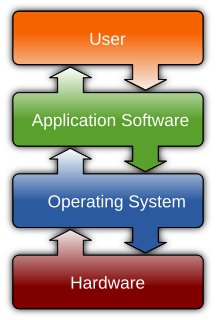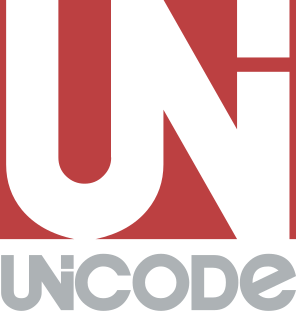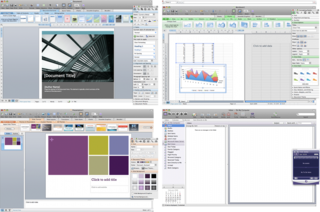This article may rely excessively on sources too closely associated with the subject, potentially preventing the article from being verifiable and neutral.(February 2015) (Learn how and when to remove this template message) |
The WASTE (an acronym for WorldScript-aware styled text engine) is an Apple Macintosh text editing software library. WASTE helps Macintosh programmers include advanced text display and editing in their applications.

Computer software, or simply software, is a collection of data or computer instructions that tell the computer how to work. This is in contrast to physical hardware, from which the system is built and actually performs the work. In computer science and software engineering, computer software is all information processed by computer systems, programs and data. Computer software includes computer programs, libraries and related non-executable data, such as online documentation or digital media. Computer hardware and software require each other and neither can be realistically used on its own.
WASTE is a memory-based editor, which places no arbitrary limit on the amount of text being edited, up to available system memory. It supports the Macintosh WorldScript system, allowing it to handle double-byte character sets and bi-directional text. It includes automatic support for undo operations, drag and drop editing, text justification, embedding images into text, and low-level hooks for rendering and measuring text.
The Zero one or infinity (ZOI) rule is a rule of thumb in software design proposed by early computing pioneer Willem van der Poel. It argues that arbitrary limits on the number of instances of a particular entity should not be allowed. Specifically, an entity should either be forbidden entirely, only one should be allowed, or any number of them should be allowed. Although various factors outside that particular software could limit this number in practice, it should not be the software itself that puts a hard limit on the number of instances of the entity.
WorldScript is the multilingual text rendering engine for Apple Macintosh's classic Mac OS, before Mac OS X was introduced.
A double-byte character set (DBCS) is a character encoding in which either all characters are encoded in two bytes, or merely every graphic character not representable by an accompanying single-byte character set (SBCS) is encoded in two bytes. A DBCS supports national languages that contain a large number of unique characters or symbols. Examples of such languages include Japanese and Chinese. Korean Hangul does not contain as many characters, but KS X 1001 supports both Hangul and Hanja, and uses two bytes per character.
WASTE version 2.0 gained support for paragraph-level formatting, additional character styles, multiple undo and redo operations, Unicode translation, and Mac OS X Carbon support, as well as providing new application programming interfaces (APIs) for printing and string matching.

Unicode is a computing industry standard for the consistent encoding, representation, and handling of text expressed in most of the world's writing systems. The standard is maintained by the Unicode Consortium, and as of March 2019 the most recent version, Unicode 12.0, contains a repertoire of 137,993 characters covering 150 modern and historic scripts, as well as multiple symbol sets and emoji. The character repertoire of the Unicode Standard is synchronized with ISO/IEC 10646, and both are code-for-code identical.
In computer programming, an application programming interface (API) is a set of subroutine definitions, communication protocols, and tools for building software. In general terms, it is a set of clearly defined methods of communication among various components. A good API makes it easier to develop a computer program by providing all the building blocks, which are then put together by the programmer.
WASTE is a popular third party library used in many Macintosh applications, formerly under the Classic Mac OS and more recently under Mac OS X, including Netscape Navigator, Internet Explorer, Microsoft Entourage, Microsoft Outlook for Mac, REALbasic, and Tex-Edit Plus.

Classic Mac OS is the series of operating systems developed for the Macintosh family of personal computers by Apple Inc. from 1984 to 2001, starting with System 1 and ending with Mac OS 9. The Macintosh operating system is credited with having popularized the graphical user interface concept. It was included with every Macintosh that was sold during the era in which it was developed, and many updates to the system software were done in conjunction with the introduction of new Macintosh systems.
Netscape Navigator was a proprietary web browser, and the original browser of the Netscape line, from versions 1 to 4.08, and 9.x. It was the flagship product of the Netscape Communications Corp and was the dominant web browser in terms of usage share in the 1990s, but by 2002 its use had almost disappeared. This was primarily due to the increased use of Microsoft's Internet Explorer web browser software, and partly because the Netscape Corporation did not sustain Netscape Navigator's technical innovation in the late 1990s.
Since WASTE uses deprecated QuickDraw features, it was deprecated in Mac OS X version 10.4 [1] and unsupported as of version 10.6.[ citation needed ]
QuickDraw is the 2D graphics library and associated Application Programming Interface (API) which is a core part of the classic Mac OS operating system. It was initially written by Bill Atkinson and Andy Hertzfeld. QuickDraw still existed as part of the libraries of Mac OS X, but had been largely superseded by the more modern Quartz graphics system. In Mac OS X v10.4, QuickDraw has been officially deprecated. In Mac OS X v10.5 applications using QuickDraw cannot make use of the added 64-bit support. In Mac OS X v10.8, QuickDraw header support was removed from the operating system. Applications using QuickDraw will still run under OS X 10.8 through macOS 10.12; however, the current versions of Xcode and the macOS SDK do not contain the header files to compile such programs.








